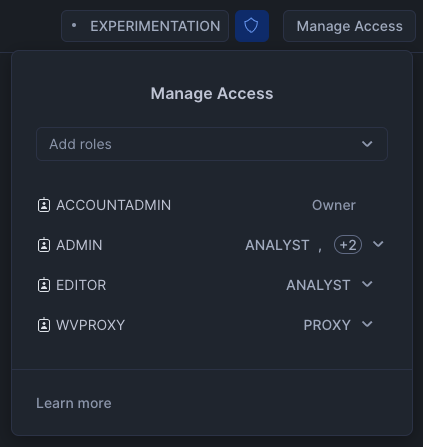Overview
Use the API described below to get or set experiment assignments from anywhere. This is especially useful for use cases that exist outside of Snowflake, such as in your app/platform. The hostname for the API can be retrieved by clicking the App from within Snowflake: Data Products > Apps > Winning Variant Experimentation. The hostname for “Variant API” is the one you’ll use.Experiment Assignments
POST /experiment-assignments
Use this endpoint to get or set assignments for a list of subject IDs in a given experiment. If an assignment already exists, it is returned, otherwise a new one is created and returned.
Request Body
The request accepts a JSON-formatted body with the following parameters:| Parameter | Type | Required | Description |
|---|---|---|---|
experiment_id | string | Yes | The ID of the experiment to get/set assignments for. |
subject_ids | string[] | Yes | List of subject IDs to get/set assignments for within the given experiment. |
Response
A JSON object with a single key,assignments , itself another object with key-value pairs. The key is the subject ID originally provided and the value is the variant it’s assigned within the experiment.
Examples
Get an assignment for a single subject In this example, we request an assignment for useruser_123 in experiment MY-EXPERIMENT. The response indicates that the subject is assigned the CONTROL variant.
Public Access
Snowflake currently does not allow unauthenticated public internet access to any service on its platform. Since any experiments running outside of Snowflake will ultimiately need access to the Variant API running inside of the application, you will need to deploy some sort of reverse proxy or forwarding service that takes public traffic and authenticates it with Snowflake.Authenticate using Programmatic Access Tokens (Recommended)
The recommended approach to accessing Snowpark Container Services (including those deployed through the Winning Variant Native App) is to use Programmatic Access Tokens (PAT). Follow the documentation provided above from Snowflake to enable this for your account. Once a PAT is generated for a user mapped to theproxy application role, you can deploy your own simple reverse proxy that appends the Authentication header or use a forwarding service, such as one through Cloudflare.
Authenticate using OAuth
If you’re unable to use Programmatic Access Tokens, you can use Snowflake’s standard OAuth flow to authenticate traffic. Due to the necessary token exchanges and refreshes associated with this approach, Winning Variant has released its own open source reverse proxy, icebreaker, built on top of nginx. This project handles the OAuth flow and refreshes for you automatically. In order to keep our promise of data control and privacy, we provide instructions below on how to set up this reverse proxy within your own cloud environment. Alternately, Winning Variant is happy to host this for you as a managed service offering. 1. Create a role Create a role in your account that will be mapped to the app’s role, which only has access to the Variant API endpoint. You can name this whatever you like, but we useWVPROXY in our examples:
PROXY application role created by the app. This will give it usage of the service that serves the Variant API.

/experiment-assignments and /healthz endpoints only.
Health Checks
A health check is available at /healthz, which returns a 200 status code if the service is alive and able to communicate with the appropriate Snowflake database. This health check is used by Snowpark Container Services, but may also be used by you to monitor uptime.
Winning Variant would also like to monitor the uptime of your reverse proxy, so please provide the hostname of the service, when live, and add this list of IP addresses to your allowlist.
